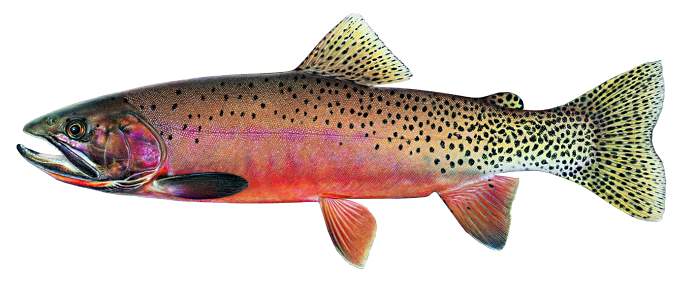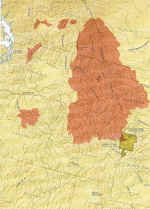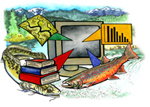Bibliography Background About KRIS
Kootenai River Westslope Cutthroat Trout

Westslope Cutthroat Trout illustration copyright Joseph R. Tomelleri
The cutthroat are the most widely distributed of western trout. The westslope cutthroat (Oncorhynchus clarki lewisi) is one of five species that began evolving from a common ancestor about a million years ago (Behnke, 2002). The westslope cutthroat is thought to have invaded the upper Columbia and Kootenai basins with the retreat of the large glaciers (Trotter, 1987).
Westslope cutthroat trout exhibit three life histories, depending on where they live. Some inhabit small streams all their lives, while others live in large rivers and spawn in small streams (fluvial) or dwell in lakes (lacustrine) and spawn in streams. Some westslope cutthroat living in large Idaho and Montana lakes may migrate more than 100 miles on spawning runs (Trotter, 1987). The life span of this species varies; small stream dwellers live three or four years, while larger lacustrine and fluvial types may live to the age of six or eight.
The westslope cutthroat does not usually prey on fish, but rather chooses aquatic and terrestrial insects and crustaceans as food. This dietary preference may actually be the result of its co-evolution with the bull trout and northern pike minnow, two large predatory fish (Trotter, 1987). Very large specimens of this species would be 24 inches in length and weigh about five pounds. More typically, in small streams they would be 6-9 inches while in larger rivers they would be 16-18 inches and one to three pounds (Behnke, 2002).
 The westslope cutthroat's original range included the Kootenai River, the upper Missouri, Flathead and Clark Fork of the Snake River, as well as basins further west, such as the John Day River and the Wenatchee River watershed in the eastern Cascades of Washington. Their patchy distribution in western basins has been attributed to the great floods associated with ice dams breaking at the outlet of the ancient Lake Missoula (Behnke, 2002).
The westslope cutthroat's original range included the Kootenai River, the upper Missouri, Flathead and Clark Fork of the Snake River, as well as basins further west, such as the John Day River and the Wenatchee River watershed in the eastern Cascades of Washington. Their patchy distribution in western basins has been attributed to the great floods associated with ice dams breaking at the outlet of the ancient Lake Missoula (Behnke, 2002).
According to Behnke (2002), "the westslope cutthroat trout would have been the most widely distributed and abundant of all subspecies of cutthroat trout before environmental changes and the introduction of non-native occurred". Today, the species inhabits only 3% of its former range in Montana, although it has been widely planted in mountain lakes of the west, often outside its native range.
 Introduced rainbow trout, eastern brook trout and brown trout have displaced the native westslope cutthroat in rivers and streams. In lakes, non-native species such as kokanee, white fish and lake trout often out-compete the westslope cutthroat. Despite the great reduction in their historic range, there are still well distributed populations, some in high abundance, so the prospect for recovery of this species is hopeful (Behnke (2002).
Introduced rainbow trout, eastern brook trout and brown trout have displaced the native westslope cutthroat in rivers and streams. In lakes, non-native species such as kokanee, white fish and lake trout often out-compete the westslope cutthroat. Despite the great reduction in their historic range, there are still well distributed populations, some in high abundance, so the prospect for recovery of this species is hopeful (Behnke (2002).
Westslope cutthroat trout photo courtesy of British Columbia Flyfishing Guides
The pilot KRIS Kootenai project includes data and reports about westslope cutthroat trout. Hoffman et al. (2002) described the effects of Libby Dam on the Kootenai River trout:
"Alterations of the hydrograph have resulted in a loss of mainstem salmonid spawning and rearing habitat. Fluctuating discharges from Libby Dam force juvenile salmonids to frequently seek new habitat, increasing the risk of predation. In addition, the widely fluctuating flows prevent colonization of the varial zone by periphyton and macroinvertebrates, reducing the efficiency with which energy is transferred from one trophic level to another. Abundance and diversity of important aquatic invertebrates has declined since construction of Libby Dam (Hauer et al. 1997), further reducing food abundance for trout. All of these factors combined have likely resulted in reduced trout abundance in the Kootenai River."
Hoffmann et al. (2002) also describe mitigations for the operation of Libby Dam and other measures being taken to offset declines of the species. KRIS Kootenai contains a report on Trout Creek (Kootenai Tribe and Kruse, 2002) that found westslope cutthroat to be doing well in headwater areas but less well in lower reaches of the stream.
 This Chart shows the annual number of adult westslope cutthroat trout caught at the Young Creek fish trap for the years 1970-2001. The number of adults increased from 1970 to 1976, and then declined from 1977 to 2001. Data were not collected in 1978. All fish greater than 250 mm were considered to be adults. Some fish caught in 2001 may have been produced by a remote site incubator project. These data suggest a decline in west slope cutthroat trout after 1984 until none were trapped in 2002. Data are from a Montana Department of Fish, Wildlife, and Parks report by Hoffman et al. (2002). Chart from pilot KRIS Kootenai project.
This Chart shows the annual number of adult westslope cutthroat trout caught at the Young Creek fish trap for the years 1970-2001. The number of adults increased from 1970 to 1976, and then declined from 1977 to 2001. Data were not collected in 1978. All fish greater than 250 mm were considered to be adults. Some fish caught in 2001 may have been produced by a remote site incubator project. These data suggest a decline in west slope cutthroat trout after 1984 until none were trapped in 2002. Data are from a Montana Department of Fish, Wildlife, and Parks report by Hoffman et al. (2002). Chart from pilot KRIS Kootenai project.
References
Behnke, R.J. 2002. Trout and Salmon of North America. Free Press, Simon and Shuster, Inc. N.Y., N.Y. 359 p.
Hoffman, G., B. Marotz, J. DeShazer, L. Garrow, T. Ostrowski and J. Dunnigan. 2002. Mitigation for the construction and operation of Libby dam. Annual report, 2000. Montana Fish, Wildlife, and Parks. Bonneville Power Authority project no. 199500400. Portland, OR. 161 pp. [6.9Mb]
Kootenai Tribe of Idaho (KTOI), and G. Krause. 2002. Trout Creek biological assessment: 2001. Prepared for Bonneville Environmental Foundation. KTOI Fish and Wildlife Department. Bonners Ferry, ID. 71 pp. [14.5Mb]
Trotter, P.C. 1987. Cutthroat: Native Trout of the West. Colorado Associated University Press, Boulder Colorado, 80309. 219 p.
